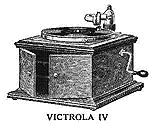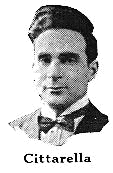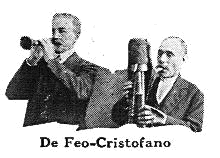
Mediterranean musicians in America (Signell)

78s:
Early 20th century recordings
Jewish | Greek | South Slav | Turkish | Italian
Comments | Tales | Signell ToC | EOL 3
In the
first half of the twentieth century, three great forces
worked in concert to create matchless audio documentation
of ethnic music in America:
As much as for jobs or religious and political freedom, immigrants were drawn to America by myth (Bohlman's "Imagining the Mediterranean," in this issue of EOL). In 1900, 13.5 percent of the population of the United States was foreign born and the figure was much higher in metropolitan areas such as New York (Historical statistics of the U.S. 1975, quoted in Gronow 1982). Until assimilated, the immigrant naturally wanted to be surrounded with familiar food, newspapers, theater, and music. In 1895, a small record company listed a handful of "Hebrew" songs in their catalog. By 1920, Victor had issued over 20,000 ethnic recordings, with Columbia rivalling that number. "In a country with strange customs and values, where other people spoke an unfamiliar language, a phonograph could and did provide a means of emotional retreat to one's homeland. Records of familiar songs reinforced traditional values and an immigrant's sense of self-worth." (Spottswood 1982). At the peak of this "Golden Age" of ethnic recordings in 1930, "folk and regional music of every description was readily and widely available on records." American-made releases were made in fifty foreign languages, from Acadian French to Welsh (ibid). The U.S. Immigration Act of 1924 and the Great Depression of the 1930s greatly reduced the flood of immigrants (Ward 1980:492-493), so there were fewer new customers for ethnic records to replace the earlier generations assimilated into the mainstream. By 1925, radio had become a formidable competitor to records with a cheaper and higher quality music. Musicians and record companies adapted to the changing demographics by offering mainstream versions of ethnic titles, prolonging its life through World War Two. But in 1952 Victor and Columbia quit the ethnic recording business (Spottswood, ibid.). Yet 1950 was the year of the birth of Folkways Records, a label which continues today as Smithsonian Folkways, joined by Arhoolie, Nonesuch, Rounder, Music of the World, and other independent labels devoted to ethnic music. Cheaper technology, innovative marketing, and effective distribution made possible a renaissance of ethnic music records (Signell 1987: "Commerce," "Technology") Richard Spottswood has catalogued more than 200,000 recordings of ethnic music recorded in the U.S. between 1893 and 1942 on U.S. Victor, Columbia, and other small and large labels. These recordings are invaluable documents of music practice and immigrant preferences of that period. From this vast ocean of ethnic recordings, I was able to find in many cases examples which related to my own late-twentieth century field recordings and to music selected by my fellow authors in this issue of EOL. The historical recordings, except for the 1893 cylinder recordings, and pictures below are from the personal collection of Richard Spottswood. The discography shows which are available on re-issued compact disc. Disclosure links to the relevant paragraph in my Tales article in this issue of EOL follow each of the ethnic subheadings below. |
|
| Jewish Only the strictist religionists (Jewish, Muslim, Christian, or others) dispute Shiloah's observation that "artistic effects in some examples make music an elevating factor of the religious experience." American record companies sold recordings of Jewish religious music and Jewish immigrants in America bought them. |
|
Audio 18 Ov horachim 150k, 300k au |
Pierre Pinchik was born in
the Ukraine. After a successful career in Europe, he
emigrated to the United States in 1925, where he became a
premiere interpreter of Jewish liturgical music. Pinchik
admired the style of the ecstatic Hasidim Jews and
incorporated elements of Hasidic style into his own (Sapoznik 1994). Ov horachim, sung by Pierre Pinchik, voice & organ was recorded in Chicago, 26 June 1928 (Audio 18). |
| Greek Spottswood lists more than 2,000 Greek recordings from a variety of genres.
|
|
Audio 19 Papagika 160K au |
Papagika recorded Zmirneïkos
Balos in New York City in 1928 (Audio 19). Ballos
(Balos) is an island dance. In Papagika's performance, the listener can hear a virtuoso vocal ornamentation style common to both cultures, full of coloratura-like roulades; and melodic modes, called dromoi (sing., dromos) in Greek and makam in Turkish. Detailed analysis of performances such as Papagika's will show to what extent they are related to makam practise of Turkish court music. Compare Greek-Turkish genres in Magrini article ("The Rebetika," and "The Tabachaniotika.") |
Audio 20 Canteris 150K au |
Haniotikos Syrtós (syrtos dance from Chaniá, Crete) was recorded with G. Canteris, lyra and G. Gombakis, laouto in NYC, 1925 (Audio 20). Compare lyra recordings by Kostas Papadakis in Magrini article ("The Cretan lyra and the influence of violin"). |
Audio 21 Papadakis 110k, 250k au |
Syrtós Kissamiotikos (syrtos from Kissamos, Crete) was recorded with Harilaos Papadakis, lyra and G. Gombakis, laouto in New York City in 1919 (Audio 21). Another lyra recording to compare with Kostas Papadakis in Magrini article (ibid). |
Audio 22 Piparakis 110K, 230K au |
Pentozali was recorded with Harilaos Piparakis, lyra in New York City, 1947 (Audio 22). Compare with pentozali recorded by Kostas Papadakis in Magrini article ("1. Crete: Learning violin and its repertory"). |
Audio 23 bouzouki 110K, 330K au |
Minore tou deke [teke] was recorded by Ioannis Halikias, bouzouki and S. Mihelidis, guitar in New York City, 1932 (Audio 23). Compare bouzouki music in Magrini article ("The rebetika") |
disclosure:Greek 78 selections, immersion, recording |
|
| South Slav Spottswood lists about 1,000 recordings from South Slavs, ethnic groups of what we now call "former Yugoslavia": Serb, Croat, Macedonian, etc. In the commercial world of record labels and catalogs, ethnic designations can be deliberately concealed for marketing purposes (Spottswood 1982:56). |
|
Audio 24 tamburica 80K au
|
A large number of South Slav recordings listed are of tamburica groups, which Pettan describes in this issue of EOL 3 as iconic Croatian, from the Pannonic region. The basic tamburica ensembe has a lead tamburica (small, plucked lute), a second tamburica following the melody in thirds or sixths, a bugarija guitar-like instrument playing on the offbeat, and a string bass. A tamburica group called "Verni's Troubadours" recorded the well-known Micika Polka in New York City in 1931 (Audio 24). Maine oska krcma kod lepe mare, performed by Dusan Jovanovich and his tamburica ensemble in New York City in 1928 is another example (Audio 25). Compare music of "Pannonic zone" video excerpt in Pettan's article. |
Audio 26 Serb epic 140K, 580K au |
One can also find a small number of Serb epics (Cf. Shiloah's "poet-musician in folk music" concept) such as Ustanak na Dahije, sung by guslar Petar Perunovich-Perun on an independent label (Audio 26). See record label.) |
Audio 27 skit 270K au |
Ratna pesma, a piece from a (Serbian?) military skit performed by Milan Pancevac and his accordion, was recorded in Chicago in 1928 (Audio 27). Compare the music in Pettan's Australian video. This kind of musical skit which re-created a social event influenced my musical narration of an Albanian wedding. |
Audio 28 Bosnian Men's choir 200K au |
A Oj Bosno is performed by Dusan Jovanovich and his Bosnian men's choir, recorded in New York City in 1926 (Audio 28). |
Disclosure: South Slav 78 selections, immersion, recordings |
|
| Turkish Spottswood lists about 220 recordings of Turkish music music, including classical Ottoman music, folk music, and the first known recording of Mediterranean music in the U.S. (1893). |
|
Audio 29 1893 cylinder 37K mp3 |
"Turkish National Hymn" [sic] performed by "four Turks" (Audio 29) was recorded by psychologist Benjamin Ives Gilman, one of the first scholars to use the phonograph in a "scientific" approach to the study of music (see Lee 1984 for complete documentation of Gilman collection). He recorded musicians on Edison wax cylinders at the "Turkish Theater" of the World's Columbian Exposition in Chicago in 1893. Gilman's notes for the other eight cylinders in this group refer to "Syrian music; players from Beyrout [Beirut]" and "Egyptian March," which without further details suggests to the modern reader that "Turkish" here could mean anything in the former Ottoman Empire. Copies of this cylinder recording for EOL were made available by permission of Harvard University's Peabody Museum of Archeology and Ethnology. |
Audio 33 Safiye 300K au |
Kâtibim, sung by the great Safiye Ayla, recorded in Istanbul in 1949 (Audio 33). Compare version by Gündüz I recorded in the 1980s. |
Audio 34 Melkon 100K au |
Ud (lute) taksim performed by Marko Melkon, recorded in New York City in 1927 (Audio 34). The Turkish-Armenian Melkon was a great favorite with 78 rpm ethnic record buyers in America. |
| Italian Spottswood lists about 7,000 Italian recordings, including many Neapolitan songs. One can also find recordings of other genres, such as street vendor cries, serenades, Christmas piping, and Sicilian tarantellas.. |
|
Audio 35 Cittarella 80K au |
 Mi
vulissa maritari, sung by Paolo Cittarella (Sicilia),
recorded in New York City in 1930 (Audio 35).
Tarantellas were among the most popular of Sicilian
dialect recordings. Mi
vulissa maritari, sung by Paolo Cittarella (Sicilia),
recorded in New York City in 1930 (Audio 35).
Tarantellas were among the most popular of Sicilian
dialect recordings. |
Audio 36 zampognari 220K au |
 La
pastorale di natale, (Christmas Eve pastorale)
performed by Zampognari della Caserta, recorded in New
York City in 1929 (Audio 36). Duo shown in picture
is similar to Zampognari della Caserta. La
pastorale di natale, (Christmas Eve pastorale)
performed by Zampognari della Caserta, recorded in New
York City in 1929 (Audio 36). Duo shown in picture
is similar to Zampognari della Caserta. |
Audio 37 vendors 180K au |
Voci dei venditori Napoletani (street cries of vendors in Naples), performed by Carolina and Guillermo Voccia, recorded in New York City in 1916 (Audio 37). |
Audio 38 Gangone 110K au |
Teggianese Dormi e riposa, performed by G. Gangone. NYC 1932 (Audio 38). |
Audio 39 mandolin solo 180K au |
Lucia sextet. Mandolin solo performed by Giovanni Gioviale. NYC 1928 (Audio 39). |
| California recordings The user can find online other recordings, photographs, and documentation of Mediterranean (Croatian, Italian, and Spanish) musicians in America at "California Gold: Northern California folk music from the Thirties" Web site of the Folklife Center of the U.S. Library of Congress (AFC 1997). | |
Present | Labels | Turkish cylinders | Sources | EOL 3
Comments